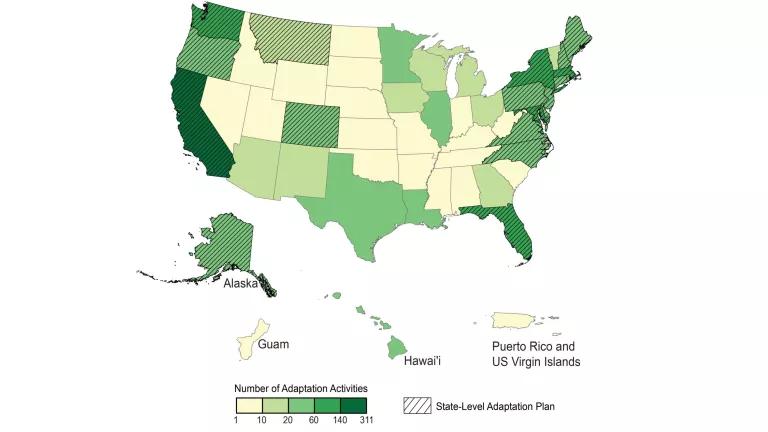World Environment Day: Confronting the Climate Crisis

The United Nations has designated today as the 45th World Environment Day, part of an annual call to better preserve and protect the life-sustaining world around us. With the climate crisis and widespread species loss growing by the day, there’s certainly no shortage of challenges for us to confront. A growing chorus of international expert reports tells us that we need to aggressively cut planet-warming pollution over the coming years in order to prevent catastrophic impacts, and climate change adaptation efforts must also be accelerated to prepare for the climate change consequences we can’t avoid. In India, a country highly vulnerable to adverse climate impacts, NRDC is working with local partners to strengthen climate resilience through novel heat-health adaptation strategies and data-driven air pollution management.
Why Is Climate Change a Health Issue?
Climate change threatens human health and well-being in a number of ways. A warming planet is putting millions of people at risk for heat-related illness and death, contributing to urban air pollution, and allowing the insect vectors that transmit infectious diseases like Lyme, Dengue fever, and West Nile Virus to expand to new territory. Meanwhile, rapidly melting glaciers are accelerating global sea level rise and displacing coastal communities at an alarming pace. Climate change pollution also stacks the deck in favor of extremes of the global water cycle, worsening both extreme drought and heavy rainfall events that can damage homes and crops, fuel stronger wildfires, and inflict serious damage to mental and occupational health. The list goes on: climate change is expected to worsen health problems like seasonal allergies, gastrointestinal illness from exposure to toxic algal blooms and cholera bacteria, and malnutrition--just to name a few.
In Focus: Heat Resilience and Air Pollution
These frightening impacts are not hypothetical; communities around the world are experiencing these effects right now, and they’re bound to get even worse if we fail to act. For example, global projections indicate that a world of 1.5 ºC warming will expose almost 4 billion people to extreme heat. For 2 ºC warming, that number climbs to almost 6 billion. Efforts are underway to better prepare communities for heat-health risks through early warning systems, urban greening, and improved local preparedness projects that draw on international best practices—but the risks remain vast.
This year’s World Environment Day is drawing attention to the role of air pollution as a critical environmental concern that has universal impacts and is fundamentally linked to our global warming problem. The World Health Organization estimates that more than 90% of the global population is exposed to unhealthy levels of air pollution, and the evidence is mounting that breathing in dirty air damages nearly every organ in the body. The latest global estimates indicate that more than 4 million people die early each year because of air pollution, and exposures to dirty air cost the global economy $5.6 trillion each year. As higher temperatures intensify both lung-damaging ozone levels and heightened demand for air conditioning, urban air pollution could worsen significantly without adequate action to improve cooling efficiency and cut carbon pollution worldwide. Pollution in the air we breathe is largely the result of the same dirty energy sources that drive climate change. Conversely, because our burning of fossil fuels causes the vast majority of global air pollution, the clean energy transition will help to stem the long-term global climate crisis and reduce the present-day burden of air pollution.
Solutions to Protect Health
India, and South Asia as a whole, is especially vulnerable to these climate-health risks. Its estimated that 800 million people in the region could be exposed to extreme heat in the future, and recent reports estimate that one out of every eight deaths in India is caused by air pollution, a rise of almost 50% since 1990. To confront these challenges and better protect vulnerable communities, NRDC is working with a constellation of local leaders and expert partners to implement practical, scalable solutions to these urgent problems.
Working alongside leaders in the Indian city of Ahmedabad and a team of accomplished partners, NRDC helped launch South Asia’s first-ever Heat Action Plan (HAP) in 2013, a comprehensive strategy centered upon a heat early warning system, government agency coordination, and broad public engagement. A recent evaluation of Ahmedabad’s HAP indicates that the city has helped avoid more than 1,100 deaths annually since implementation. As our new heat resilience fact sheet illustrates, HAPs have expanded widely to now reach 23 states and over 100 cities and districts through the collaboration of the National Disaster Management Authority (NDMA), India Meteorological Department, and partners including the Indian Institute of Public Health-Gandhinagar and NRDC.

We’re collaborating with NDMA and state and local authorities to support heat resilience and HAP implementation, through regularly updated Heat Guidelines that identify exposure mitigation efforts and the development of local heat-health thresholds that account for the changing nature of risk and vulnerability around the country.
Building on the lessons learned from implementation of Ahmedabad’s HAP, city leaders spearheaded an air pollution response plan in 2017 that utilizes newly-available air monitoring data to inform a sophisticated pollution forecasting system and a public agency response strategy. The plan aims to reduce harmful exposures by informing community members (including school children) of the many health risks posed by air pollution, especially for vulnerable populations.

Now, two years into implementation of this plan, local leaders, environmental advocates, and technical experts in Ahmedabad are strengthening their efforts to harness data on pollution sources to achieve sector-specific source reductions. Ahmedabad, and other cities, are striving to deliver on the ambitious goals of India’s National Clean Air Program, which earlier this year mandated air pollution management plans in every city that exceeds the country’s national air quality standards.
Action Is Urgent
Today’s observance of World Environment Day reminds us of the urgency of action to address both the drivers and wide-reaching impacts of the global climate crisis. As the world continues to heat up, action to reduce carbon pollution and expand the reach of climate-health adaptations is more than an environmental imperative; it is crucial for ensuring the health and resilience of humankind.




